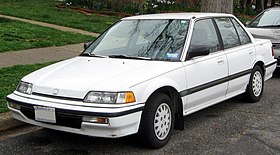Honda Civic (fourth generation)
| Honda Civic Fourth generation (EC/ED/EE/EF) |
|
|---|---|
 |
|
| Overview | |
| Manufacturer | Honda |
| Production | September 1987–August 1991 September 1987–February 1996 (Civic Shuttle) |
| Assembly |
Suzuka, Japan Swindon, England (HUKM) East Liberty, Ohio, United States (Marysville Auto Plant) Alliston, Ontario, Canada (HCM) Hsinchu, Taiwan East London, South Africa Nelson, New Zealand (Honda New Zealand) Johor Bahru, Malaysia (OASB) |
| Body and chassis | |
| Body style | 3-door hatchback 3-door coupe (CRX) 4-door sedan 5-door station wagon (Shuttle) |
| Layout | Front engine, front-wheel drive / Four-wheel drive |
| Related |
Acura Integra Honda Ballade Honda City Honda Concerto Honda CR-X Honda Integra Rover 200 (R8) Rover 400 (R8) |
| Powertrain | |
| Engine | 1.3 L D13B I4 1.4 L D14A I4 1.5 L D15B1 I4 1.5 L D15B2 I4 1.6 L D16A6 I4 1.6 L ZC SOHC I4 1.6 L B16A DOHC I4 1.6 L D16A9 I4 |
| Transmission | 4-speed manual 5-speed manual 4-speed automatic |
| Dimensions | |
| Wheelbase | 98.4 in (2,499 mm) |
| Length | 156.1 in (3,965 mm) (hatchback) 166.5 in (4,229 mm) (sedan) 161.7 in (4,107 mm) (wagon) |
| Width | 65.6 in (1,666 mm) (hatchback) 65.9 in (1,674 mm) (sedan) 66.1 in (1,679 mm) |
| Height | 52.4 in (1,331 mm) (hatchback) 53.5 in (1,359 mm) (sedan) 56.1 in (1,425 mm) (FWD Wagon) 56.9 in (1,445 mm) (4WD Wagon) |
| Chronology | |
| Predecessor | Honda Civic (third generation) |
| Successor | Honda Civic (fifth generation) |
In 1987, the Honda Civic was significantly redesigned for model year 1988. The suspension had a radical re-configuration with what Honda called "double-wishbone suspension" on all four corners, wheelbase was increased to 98.4 inches (250 cm), and the body was redesigned with a lower hood line and more glass, giving less drag. Rear suspension however is more accurately described as multi-link trailing arm suspension since the upper control arm only has a single anchor and there is toe control used on the main trailing arm.
The base model of the fourth generation Civic had a 1.2 L SOHC, this single carbureted engine was not available for the Japanese and American markets. In Japan the base version received a 1.3 L SOHC single carbureted engine, thus equipped it was called either 23L or 23U.
The 1.5 L SOHC engine came in a wide variety of models, dual-point injection, single carbureted and dual carbureted. Those engines were available in the Japanese-market 25X and 25XT. The Japanese version of the sporting Si, initially the top version, featured a (ZC) D16A8/A9 1.6 L 16V DOHC engine.
But there was more to come, and in late 1989 the new top model of the hatchback was the new SiR, fitted with the 1.6-litre, 160 PS (118 kW; 158 hp) at 7,600 rpm "B16A" DOHC VTEC engine. This, the first B engine, marked the introduction of Honda's variable valve timing and electronic lift control technology, or VTEC. By providing two different camshaft profiles—one for fuel economy, one for performance—the VTEC engines set a high-revving, naturally aspirated precedent for future performance variants of the Honda Civic. With its light weight, independent suspension and powerful engine, the car was well-received globally, receiving “Golden Steering Wheel Award” from the German newspaper Bild am Sonntag, and ranking first in France’s l’Automobile magazine 1989 survey on car quality and reliability. The European model, badged as a "1.6i-VT", used a slightly less powerful B16A1 engine, which had an 8,200 rpm redline and made 150 hp (112 kW), although it made the same 111 lbf·ft (150 N·m) of torque as the Japanese market B16. In Japan, automatic-equipped SiR Civics also received the lower-powered engine.
The wagon, known in Japan as the Civic Shuttle, continued but the commercial-use "Shuttle Pro" was replaced by a dedicated commercial delivery van called the Honda Partner starting with model year 1996.
...
Wikipedia
